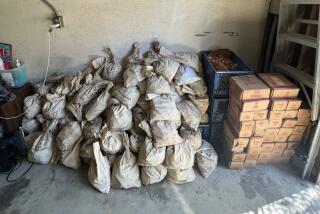A Legend in Mint Condition
- Share via
I flashed a five-dollar bill to the teller at a Bank of America branch in Ventura.
“Got Sacagaweas?” I asked.
She looked at me as if I’d just asked for Alan Greenspan’s home number.
“Do you have an account with us?”
An account! Go to a bank for a dollar’s worth of nickels and you won’t be asked if you have an account. Ask for Susan B. Anthony dollars, and they’ll throw in a toaster and a trip to Hawaii.
But if you’re looking for those new golden $1 coins with the face of Lewis and Clark’s Indian guide Sacagawea, be prepared to prove your worthiness. Demand is high and supply is low. If Sacagawea weren’t a 15-year-old Shoshone girl shepherding Lewis and Clark through a hostile land, she’d be an Internet stock.
Because the Chawkins hundreds happen to reside in a Bank of America account, I was able to secure five Sacagaweas. Within minutes, colleagues back in the newsroom bought three of them.
At Simi Valley’s Wal-Mart, Sacagawea is as tough to find these days as the Northwest Passage was for Lewis and Clark.
“We’ve been overwhelmed,” said store manager Allen Reynolds, who had to limit customers to 10 Sacagaweas at a time since their release five weeks ago. “When we had customers asking for them even before they were issued, we knew this would be really monumental--and it was.”
So what is it about this Sacagawea? I wanted to know.
How is it people could have detested the Susan B. Anthony dollar, yet profess to love the Sacagawea--which is, after all, just more pocket ballast, yet another coin to confuse with a quarter as you grope for change.
Philip N. Diehl, the director of the United States Mint, has his theories about the new girl in town.
“It’s an aesthetic issue,” he said. “The Susan B. Anthony dollar wasn’t the most attractive coin around. And Susan B. Anthony herself was, well, a little grim.”
I suppose the bad news for some would be that in coins, as in life, youth is golden.
On the other hand, that’s part of Sacagawea’s allure. She is the only teenager--a teen mother, no less--ever featured on U.S. coins, which tend to be heavy with deceased presidents and financiers.
“It’s really neat how preteen and teenage girls have taken to this coin,” Diehl said. “I’ve heard from parents over and over again how much they love it.”
Diehl said the idea of a new $1 coin was researched exhaustively. Bankers, retailers, vending-machine manufacturers, bus companies all said the same thing: Nobody wants a $1 coin, especially after Susan B.’s notorious flop.
But, with its eyes on dollars-and-cents issues, the mint persisted. Folding money has to be replaced every few years but coins circulate for decades.
In addition, Diehl saw the opportunity to conjure up excitement for a $1 coin with the right subject, the right story, the right design, the right marketing.
After looking at 120 other women in U.S. history, the mint settled on Sacagawea. Her bio is compelling: Torn from her family by a rival tribe. Enslaved. Sold to a 45-year-old French Canadian trapper. Enlisted by Lewis and Clark as a guide. Credited with helping the expedition survive.
Sacagawea was brave, resourceful, dignified and even-tempered in the face of adversity. When expedition leaders asked her which river to follow, or how soon the snow would be coming, or whether eating some red berry would kill them, she never once looked at them as if they were morons, rolled her eyes and muttered: “What. Ever.”
That alone should make her worthy of a coin.
The Sacagawea--the government calls it “The Golden Dollar”--has been available off and on at Wal-Mart and Sam’s Club stores since late January.
After banks indicated they didn’t want to get involved with another Susan B. Anthony fiasco, the mint arranged to use those stores as their main distributors during Sacagawea’s first month. Now the banks are clamoring for Sacagawea, and millions of fans struck with her beauty are keeping the coins around the house, Diehl said.
“The trick is to get Americans to let go of them,” he said. “These coins are meant to be spent.”
Steve Chawkins can be reached at 653-7561 or by e-mail at steve.chawkins@latimes.com.
More to Read
Sign up for The Wild
We’ll help you find the best places to hike, bike and run, as well as the perfect silent spots for meditation and yoga.
You may occasionally receive promotional content from the Los Angeles Times.







